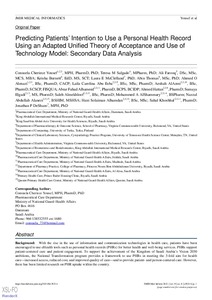Predicting Patients’ Intention to Use a Personal Health Record Using an Adapted Unified Theory of Acceptance and Use of Technology Model: Secondary Data Analysis
Alhameed Abrar Fahad; Salgado Teresa M.; Abu Esba Laila Carolina; Khoshhal Sahal; Alhamdan Hani Solaiman; Burnett Keisha; Almekhloof Saleh; DeShazo Jonathan P.; Hattan Ahmed; Farooq Ali; Elgadi Sumaya; Thomas Abin; AlAzmi Aeshah; Alenazi Ahmed O.; McClelland Laura E.; Yousef Consuela Cheriece; Alanezi Nazzal Abdullah; AlShammary Mohammed A.
https://urn.fi/URN:NBN:fi-fe2021093049050
Tiivistelmä
Background
With the rise in the use of information and communication technologies in health care, patients have been encouraged to use eHealth tools such as personal health records (PHRs) for better health and well-being services. PHRs support patient-centered care and patient engagement. To support the achievement of the Kingdom of Saudi Arabia's Vision 2030 ambitions, the National Transformation program provides a framework to use PHRs in meeting the triple aim for health care - increased access, reduced cost, and improved quality of care - and to provide patient- and person-centered care. However, there has been limited research on PHR uptake within the country.
Objective
Using the Unified Theory of Acceptance and Use of Technology (UTAUT) as the theoretical framework, this study aims at identifying predictors of patient intention to utilize the Ministry of National Guard-Health Affairs (MNG-HA) PHR (MNGHA Care) application.
Methods
Using secondary data from a cross-sectional survey, data measuring intention to use the MNGHA Care application along with its predictors, were collected from adults (N=324) visiting MNG-HA facilities in Riyadh, Jeddah, Dammam, Madinah, Al Ahsa, and Qassim. The relationship of predictors (main theory constructs) and moderators (age, gender, experience with health applications) with the dependent variable (intention to use MNGHA Care) was tested using hierarchical multiple regression.
Results
Of the eligible population, a total of 261 adult patients were included in the analysis with a mean age of 35.07 years (± 9.61), male (n=132, 50.6%), university-educated (n=118, 45.2%), and at least one chronic medical condition (n=139, 53.3%). The model explained 48.9% of the variance in behavioral intention to use the PHR (P=.377). Performance expectancy, effort expectancy, and positive attitude were significantly associated with behavioral intention to use the PHR (P<.05). Prior experience with health applications moderated the relationship between social influence and behavioral intention to use the PHR (P=.043).
Conclusions
This research contributes to the existing literature on PHR adoption broadly as well as in the context of the Kingdom of Saudi Arabia. Understanding which factors are associated with patient adoption of PHRs can guide future development and support the country's aim of transforming the health care system. Similar to other studies on PHR adoption, performance expectancy, effort expectancy, and positive attitude are important factors, and practical consideration should be given supporting these areas.
Kokoelmat
- Rinnakkaistallenteet [19207]
